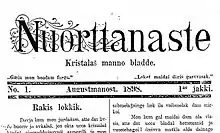Nuorttanaste
Nuorttanaste is a Northern Sámi religious publication based in Norway. It has published continuously since 1898, making it the longest running Sámi publication still being published.
 | |
| Editor | Ann Solveig Nystad |
|---|---|
| Launched | 1898 |
| Language | Northern Sámi |
| Headquarters | Kárášjohka, Norway |
| ISSN | 0333-418X |
| Website | nuorttanaste.no |
History
Nuorttanaste (modern Northern Sámi spelling Nuorttanásti), which means "The Eastern Star," was founded by “sled preacher” Gustav Lund, a travelling pastor of the Evangelical Lutheran Free Church of Norway who sought to evangelize Sámi in part by using their native tongue. In 1898, he founded Nuorttanaste in Finnmark, and the paper soon began publishing news articles and letters from readers alongside its religious content. The reporters and correspondents balanced the publisher's desire for religious content with readers' desire to receive news in their native language. [1]
The first issue of Nuorttanaste was printed by Lund using a portable printing press. As the paper grew, it established formal offices in Sigerfjord. Over the years it moved several times before setting up its first permanent printing press was in Gáivuotna. The press alternated between Gáivuotna and Oslo for several years before setting up offices in Vuonnabahta in 1960. In 1992, the paper's headquarters moved to Kárášjohka.
For much of its history, including during World War II, Nuorttanaste published twice a month; it currently publishes 11 issues each year. It has subscribers in Norway, Sweden, and Finland.[2]
Editors
- 1898–1912: Gustav Lund
- 1912–1916: Ole A. Andersen
- 1916–1948: Henrik Olsen Heika
- 1948–1960: Anders Guttormsen
- 1960–1992: John Ole Nilsen
- 1992–2003: Ann Solveig Nystad
- 2003–2013: Olaug Balto Larsson
- 2013–2016: Liv Tone Boine
- 2016–: Ann Solveig Nystad
Cultural impact
For much of the 20th century, Nuorttanaste was the only newspaper publishing in Northern Sámi. Therefore the paper played a major role in supporting Sámi literacy, along with Sámi language and culture.[3]
For most of its publication history, Nuorttanaste has used the J.A. Friis orthography, which is the same writing system used for the Sámi Bible.[4] From 1948 to 1958, the paper used the Bergsland–Ruong orthography, which was the standard for writing Northern Sámi in Norway and Sweden (but not Finland), before reverting to the J.A. Friis orthoraphy. Since 2004, Nuorttanaste has used the pan-Scandinavian 1979 orthography.[5]
References
- Solbakk, Aage. "Sámi mediahistorjá" [Sámi Media History] (in Northern Sami). Kárášjohka, Norway: ČálliidLágádus. Retrieved 28 April 2020.
- "Nuorttanaste - Bures boahttin" (in Northern Sami). Nuorttanaste. Archived from the original on 2009-09-10. Retrieved 2009-07-01.
- Somby, Katri S. (2010). "Nuorttanaste — Vuoiŋŋalaš bláđđi vai sámi servvodatguoddi" [Nuorttanaste — Spiritual Magazine or Sámi Community Carrier] (PDF). Sámi Dieđalaš Áigečála (in Northern Sami) (2). Retrieved 21 October 2019.
- Strategic Plan for Sami Church Life (PDF). Oslo, Norway: The Sami Church Council, the Church of Norway. 2011. pp. 52–53. ISBN 9788275451079. Retrieved 13 May 2020.
- Kahn, Lily; Riitta-Liisa, Valijärvi (2017). North Sámi: An Essential Grammar. Milton Park, England: Taylor & Francis. p. 8. ISBN 978-1-317-55811-8. Retrieved 12 May 2020.